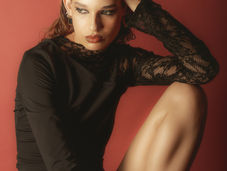"Rachel Maclean: The Lion and The Unicorn": An Exhibition of National Identity and Satire
- Nina P. Willms
- Dec 3, 2018
- 3 min read
29 November 2018 – 3 February 2019
FREE entry
Walking through the doors leading to one of the National Gallery’s newest exhibitions transports the visitor to the world of Rachel Maclean – dark, gaudy and satirical. The room is painted with rich, dark colours, draped with red curtains and glowing with the light of the illuminated prints along the walls and the moving lights of the art film in the inner room. Rachel Maclean: The Lion and The Unicorn provides a haunting glimpse into Maclean’s exploration of collective and individual identities.
Combining a knowledge of historical events and figures with a keen understanding of popular culture, Maclean creates a world of dialogue focused on the exploration and expression of Scottish national identity and its relationship with Britain. The prints combine art historical motifs, references to pop culture and traditional symbolism to develop a unique and striking collection of satirical photography. Maclean uses masks and costumes to place herself within these images as the characters, lending an insight toward the interaction of the individual with the collective. In using her own face for all the figures, Maclean creates a haunting sense of lost individuality within a collective narrative.

The prints contain recognisable scenes of national iconography, making the satirical material based on national identity and cleverly tied to art historical subjects. Common motifs involve the presence of money and resources as a driving force for the maintenance of a union between Scotland and England that otherwise causes hardship for the Scottish nation. Images of suffering, pain and injustice haunt the viewer, while the presence of the whimsical and diplomatic ‘Queen’ adds another layer to the complicated and difficult topic Maclean seeks to satirise.
The centrepiece of the exhibition, The Lion and The Unicorn, is a 2012 film illuminating Anglo-Scottish relations through a similar lens. Again, Maclean’s dark, gaudy and creative satire reigns supreme in this haunting depiction of political conflict. Maclean acts as the three characters within the film – the Queen, a representation of the monarchy and the tradition of Great Britain; the Lion, a representation of England; and the Unicorn, a representation of Scotland. The two figures of the Coat of Arms are seen arguing over the future of the Union, while the Queen addresses the viewers with an appeal to the tradition of union and a demand for the courage to maintain it. As the 11-minute film progresses, the Lion destroys the Unicorn’s act of defiance and claims his supremacy as the Unicorn dies in his chair, oil dripping from his mouth. Throughout the film, much attention is paid to the Union, with the English and British parties asserting its fairness, glory and tradition, while the implicit feelings of inequality and injustice create an uncomfortable and haunting atmosphere. A depiction of national identity – both its individual and collective manifestations – is inherently thought-provoking. The medium through which Maclean creates this dialogue is memorable and satirical, instilling her discourse in the minds of her viewers.
A unique quality of the film is its use of found audio clips for the dialogue. Maclean did not write any of the words spoken by the characters – rather, she used clips from the Queen’s 1957 Christmas Broadcast and spoken clips of broadcaster Jeremy Paxman and former 1st Minister of Scotland Alex Salmond to provide the voices of the characters she portrayed. The symbolic characters of the film took on the voices of these individuals, lending a quality of reality to the strange dream world created by Maclean. Maclean herself adopts the voices as she portrays her characters, making herself, the artist, a medium through which a real dialogue takes place. The strange, dark, gaudy world created by Maclean becomes much more tied to reality as recognisable voices speak for themselves, creating the conflict Maclean attempts to identify.
The exhibition is part of the National Gallery’s Modern and Contemporary Programme for 2018-19, and is shown in conjunction with the exhibition Landseer’s The Monarch of the Glen, drawing on themes of national identity to create a comparative statement across different mediums. The curator of Rachel Maclean: The Lion and The Unicorn, Daniel Hermann, explains the ways in which contemporary art provides viewers and artists with ‘a chance to think.’ In the case of Maclean, Hermann emphasises the importance of her engagement with past art collections to create new works and her ability to combine history and popular culture to promote a lasting statement. The unique quality of her work – both methodological and conceptual – makes this exhibit both important and memorable.
























Comments